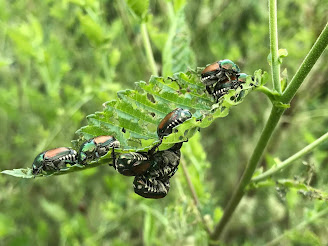If you've read my blog for any length of time, you know that the most often subjects I write about are growing basil, garlic, weather, and dealing with Japanese beetles. Here we go again.
Believe it or not, the adult green/copper despicable Japanese beetles you see in your yard today began life last summer. In fact, their one-year life cycle is about to end. What? Explain please. Sure.The beetles you're seeing today are doing their thing - eating, mating, resting on plants in the morning and evening. Their behavior causes more gardener frustration then a July hailstorm (maybe not). JBs will mate into September or so, afterwhich they die.
A year ago these same adults started their one year life as an egg that was laid by female beetles in your yard and yards all around town.
This diagram shows their life cycle much better than my words -
 |
Photo from USDA printed with permission by the Sacramento Bee
|
In September this summer's generation all die off, some are dying now because they've already lived their ~sixty day summer adult life span.
Back to females - they lay eggs in lawns from the time they emerge in early summer. They prefer cool-season irrigated grass turf (that's why golf courses struggle with Japanese beetle management too). Each female lays between 40 and 60 days during her lifetime. They have simple lives, really. Mate, chew and destroy your plants, mate some more, lay eggs - pick any order.
Eggs laid in lawns develop into white grubs, also called larvae, and will remain below your turf grass until next spring. Technically, they have a much longer life in the soil -- nine-ten months. In May to June, white grubs will pupate for a few weeks before emerging from grass to finish out their one year life as an adult beetle. The cycle begins again.
It's common practice where Japanese beetles are troublesome to kill next year's generation each summer. Makes perfect sense, except. The except part means that even if you treat your lawn this summer, Japanese beetles can still fly in from other lawns and gardens next year. So why should you treat your lawn? I believe everyone has to decide for themselves the best plan for their landscape.
I like to treat my lawn every summer. My concern is for the health of the lawn (white grubs eat grass roots - see the diagram). Lots of white grub chewing can lead to dead areas in the lawn. Damage can get bad, to the point of needing to be re-seeded or sodded this fall or next spring. Critters like raccoons and skunks add to turf destruction by digging to find and eat the grubs.
Another reason I treat my lawn yearly is I like knowing that I'm killing the next generation of adult beetles, even though adult beetles can and will fly in from other areas next summer.
Early August is a great time to apply a lawn product to kill the eggs
and white grubs (next year's beetles). Generally only one
product is needed per summer.
The best reference chart to view white grub control products, timing and environmental concerns is from Dr. Whitney Cranshaw, Emeritus Entomologist at Colorado State University. View it below or on his very informative fact sheet on Japanese beetle, click here.
Click on the box with angled arrow in upper right corner to open into a larger format.
Whatever product you choose to use, please read all the package instructions,
Two products
are very low to no impact to beneficial insects, people, pets, etc. Beneficial nematodes (mix and spray) and grubGONE! (granular application with spreader). Both products should be available locally at independent garden centers or online.
There is long-term good news on the Japanese beetle battle front. Dr. Cranshaw and the Colorado Department of Agriculture
are responsible for bringing very safe biocontrol agents that specifically attack adult
beetles and white grubs to Denver, Boulder and Pueblo. The program started in 2015. I wrote about
the three controls in 2018 in a Denver Post article, read here. You can also view the twenty PowerPoint slides I've put together on the three agents here. This link can be found on my Japanese beetle website under Fact Sheets, half way down the page.
Efforts continued this summer with additional biocontrol agent releases. I was fortunate to have one of the three agents released in our yard - click here to view my short YouTube videos on the release (there are seven short videos). Link to my YouTube Channel from my blog home page, upper left.
I close with this important information about beneficial biocontrols for Japanese beetle management. Down the road, probably way down the road from now, IF/WHEN these biocontrols get well established along the Front Range area, then the use of spray products and or grub control products to kill Japanese beetles should cease entirely.
Otherwise the spray you use on adult beetles, dunking in soapy water and the granular or spray used on lawns WILL also kill the beneficial biocontrol agents. We are not there yet, but I will keep you posted on the progress of the biocontrol releases and establishment. Hopefully any good news will make front page print and online news everywhere in Colorado. Please pass this along.
Additional Resources:
Japanese Beetle Management in Colorado - My Dedicated Japanese Beetle Website
Products to Manage Adult Japanese Beetles All Summer
Cultural Ways to Reduce Japanese Egg Laying all Summer
Plants - From Resistance to Extensive Feeding
Japanese Beetle Fact Sheet 5.601 - Dr. Whitney Cranshaw






